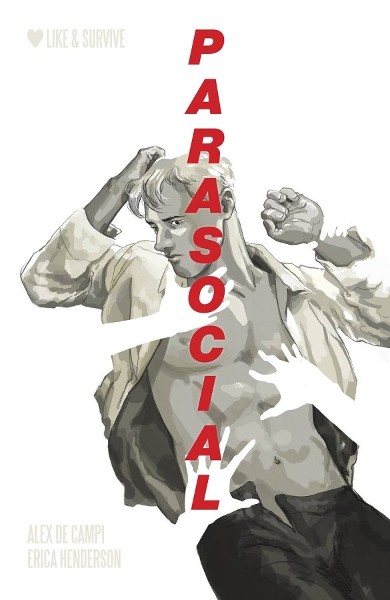The Haunting Twists and Moral Unease of “Parasocial”
Alex de Campi and Erica Henderson reteamed for the graphic novel "Parasocial," an unsettling story with plenty of formal innovations.

A little over a year ago in this very space, I wrote about an original graphic novel from writer Alex de Campi and artist Erica Henderson titled Dracula, Motherf**ker! With impressionistic art and a revisionist take on a familiar story, de Campi and Henderson established themselves as a prodigiously talented collaboration. Their latest book doesn’t just clear the high bar they set last time; it also demonstrates that these two are capable of telling vastly different stories than ones in the vein of their earlier book.
Their latest graphic novel is called Parasocial, and it follows an actor named Luke Indiana as he makes his way to a comicon. Soon enough, de Campi and Henderson establish a few things: Luke’s marriage and career are both on the rocks; Luke was once on a beloved science fiction show, Rogue Nebula; and Luke was something of a shit to his colleagues on said show.

Parasocial is set in the recent past, long enough since the pandemic began that things like conventions are happening again, but still close enough that Luke is posing for photos with fans with a divider between them. It’s a relatively effective metaphor for his isolation; it also lets Henderson cut loose with some memorable body language and facial expressions. Something that we glean from these early interactions is that Luke is, if not a great guy, certainly less of a bad guy than he was during his heyday. Maybe it’s because life has taken him down a peg; maybe it’s because he has genuine regrets. As readers, we’re only able to know so much about his inner life, which makes the way the plot escalates from there that much more effective.
On the way back to his hotel from the convention, Luke is in a car accident. A fan he’d encountered earlier in the day, Lily, is on the scene and lets him borrow her phone charger; she also gives him some Gatorade, which turns out to be drugged. He passes out, and when he wakes up he’s in Lily’s house, tied up, his fate uncertain.
As Vita Ayala points out in their blurb, there’s a bit of Stephen King’s Misery at play here, though Lily emerges as a more sympathetic character than Annie Wilkes. (“Sympathetic” being very subjective in both cases.) But Luke is also a more ambiguous figure here. In his interactions with Lily on the side of the road, his conduct seemed to be, to these eyes, entirely above-board. What makes Parasocial especially unsettling, then, is the sense that he’ll have to become an awful cliche — a famous man flirting with a fan, and maybe more than that — to get his freedom.
It’s here that I should bring up de Campi and Henderson’s more innovative uses of the format. Throughout the book, panels and gutters include pieces of social media, from chat logs to excerpts from fanfic. As they go deeper and deeper into this increasingly fraught encounter between two people, de Campi and Henderson further blur the lines between fantasy and reality.
Elsewhere in the book, Henderson and de Campi have dialogue and captions interact with the storytelling in unexpected ways. It’s another way of keeping readers on their toes; it’s asking them to read this book differently than they might other examples of the format. And for enthusiasts of the medium itself, there’s a lot to savor here. These formal innovations come up in other ways as well, including the color effects used to signify flashbacks, which opt for a kind of disintegration — evoking both Luke’s precarious situation and the nature of memory. In an afterword, Henderson writes, “I’m not someone who’s shy about leaning into the absurd in the comic format.” That’s a welcome decision here.
At the heart of this book is an extended conflict between two people with life-or-death stakes. That doesn’t mean that this book isn’t also wryly funny in places; early on, at the convention, one fan offers some insights into the show that made Luke famous: “What Rogue Nebula did have was three hot lead characters and the dizzying levels of queer subtext that can only be achieved by clueless straight people.”
That said, this is also a book that heads to morally dark and deeply visceral places. Late in the book, Luke tells a story about one of his ancestors and the Angel of Death. (Spoilers ahead.) At a point near the end of Parasocial, we see Luke with two bloodstains on his back that look…not unlike wings. This is a book that leaves the reader constantly re-evaluating how they feel about its two central characters. The result is a haunting character study as well as a work that pushes the medium forward.